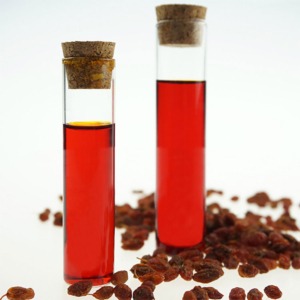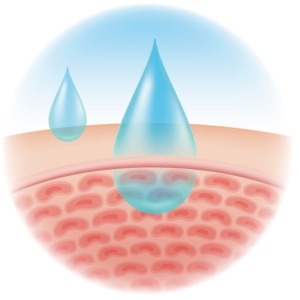Unsaturated fatty acids present themselves as colorless liquids under normal conditions and are classified into monounsaturated (MUFA) and polyunsaturated (PUFA) fatty acids. They are further distinguished accordingly to the number and location of the double cis bonds about the carboxyl terminus as omega- (n-, delta-) 12, 11, 9, 7, 6, 5, and 3 fats. Two fatty acids, linoleic acid 18:2(n-6) and linolenic acid 18:3(n-3) are essential and must be obtained from dietary sources.
Additionally, many plant secondary metabolites found in small amounts in unsaturated botanical oils have complimentary anti-inflammatory, antimicrobial, and antioxidant properties that can be also utilized to manage clinical manifestations associated with skin damage or an immune disorder.
Oleic Acid 18:1(n-9) and Petroselinic Acid 18:1(n-12)
Oleic acid 18:1(n-9) is the most common botanical MUFA that is classified as omega-9. It is also the most common fatty acid of human adipose tissues (47–52%), followed by palmitic (22–25%), linoleic (11–13%), stearic (4–8%), palmitoleic (4–8%), and myristic (2–3%) acids.
 Oleic acid triglycerides comprise the majority of botanical oils, including carrot seed oil, pataua oil, Camellia tea seed oil, papaya seed oil, marula oil, moringa oil, almond oil, apricot oil, and rice bran. High oleic (70–80%) cultivars of sunflower, safflower, and canola have been also developed as a primary source of dietary vegetable oils. Due to the presence of a cis double bond, the addition of oleic acid 18:1(n-9) to lipid bilayers increases instability and progressive structural loss.
Oleic acid triglycerides comprise the majority of botanical oils, including carrot seed oil, pataua oil, Camellia tea seed oil, papaya seed oil, marula oil, moringa oil, almond oil, apricot oil, and rice bran. High oleic (70–80%) cultivars of sunflower, safflower, and canola have been also developed as a primary source of dietary vegetable oils. Due to the presence of a cis double bond, the addition of oleic acid 18:1(n-9) to lipid bilayers increases instability and progressive structural loss.
Oleic acid 18:1(n-9) is toxic to keratinocytes when applied directly to the cells, and this effect is decreased in the presence of the functional epithelium barrier of the skin. Mild visible skin irritation and increased traffic of the inflammatory cells, combined with increased interleukin (IL)-1α and other cytokine production, have been also observed.
Similarly, almond and avocado oils showed moderate skin and eye irritation when tested as pure oils and 2–10% aqueous emulsions in a subchronic 90-day repeated dose study in the rabbit. While dietary intake of olive oil has several beneficial effects on metabolic and skin health, its topical application is less effective due to its sensitizing or irritant effects and can be largely attributed to its polyphenol and squalene content.
The beneficial effects of avocado oil on collagen metabolism, argan oil on cardiovascular health, and oat lipids on keratinocyte differentiation are also likely mediated by secondary bioactive compounds found in these oils.
Petroselinic acid is a naturally occurring positional isomer of oleic acid that belongs to omega-12 fats. Found in parsley Petroselinum crispum (Mill.) Fuss, coriander Coriandrum sativum L., and geranium Geranium sanguineum L. seed oils exhibit disruptive tendencies in the lipid structures of the stratum corneum similar to those of oleic acid.
Gondoic Acid 20:1(n-9), Erucic Acid 22:1(n-9), and Nervonic Acid 24:1(n-9)
These monounsaturated long-chain fatty acids are omega-9 elongation products of oleic acid 18:1(n-9) found in small quantities in some botanical oils. Camellia seed oil is the major source of gondoic acid 20:1(n-9), while jojoba and mustard oils are the major sources of erucic acid 22:1(n-9) and nervonic acid 24:1(n-9). Similar to oleic acid, these molecules disrupt skin lipid layers and enhance the permeation of drugs. Dietary supplementation with omega-9 fats can be also protective against metabolic risk factors associated with cardiovascular disease.
In rare instances when β-oxidation of long-chain saturated fatty acids is genetically disrupted, supplementation with long-chain nonanoic acid fatty acids can be beneficial to slow down demyelination.
However, dietary supplementation with erucic acid 22:1(n-9) induces alopecia and scaly skin lesions similar to those observed in essential fatty acids deficiency, suggesting that this fatty acid may interfere with the dermal metabolism of essential fatty acids.
Myristoleic 14:1(n-5), Palmitoleic 16:1(n-7), and Paullinic 20:1(n-7) Acids
These fatty acids are desaturation omega-5 and omega-7 products of the respective saturated fatty acids. Less common in nature, these fatty acids are found in small quantities in butter and animal fats. Among plant sources, nutmeg and saw palmetto oils contain measurable levels of myristoleic acid 14:1(n-5), while sea buckthorn oil and macadamia nut oils are a good source of palmitoleic acid 16:1(n-7).
Pauline acid 20:1(n-7) is rather uncommon, but it can be found in large quantities (40%) in guarana (Paullinia Elegans Cambess.) seed oil, alongside another uncommon cis-vaccenic acid 18:1(n-7) (20%).
While generally regarded as an anti-inflammatory, especially in the case of palmitoleic acid 16:1(n-7), their direct application to metabolic and immune health remains unclear. Direct effects of palmitoleic-rich sea buckthorn oil or palmitoleic acid 16:1(n-7) alone on wound healing and skin aging was confirmed, and sea buckthorn fruit oil (but not seed oil) was shown to improve symptoms of atopic dermatitis following oral supplementation with 5 g oil daily for 4 months to 49 subjects as a part of a placebo-controlled, double-blind clinical study.
Linoleic Acid 18:2(n-6)
Linoleic acid 18:2(n-6) is the most common botanical PUFA that is classified as essential omega-6 fat. Large quantities of linoleic acid are found in evening primrose, safflower, sunflower, coffee beans, sesame, passion fruit seed, poppy seed, grape seed, watermelon seed, walnut, black cumin seed, hemp, raspberry seed, cottonseed, corn, soybean, pumpkin seed, rosehip, black currant seed, borage, cranberry seed, and sea buckthorn seed oils.
In humans, it serves as a starting point for the biosynthesis of long-chain PUFAs, such as γ-linolenic acid 18:3(n-6), dihomo-γ-linolenic acid 20:3(n-6), and arachidonic acid 20:4(n-6), the latter being the major precursor to prostaglandins, leukotrienes, and endocannabinoids. Linoleic acid 18:2(n-6) is also selectively targeted for β-oxidation in the sebaceous gland to synthesize squalene and wax esters. Low levels of linoleic acid 18:2(n-6) also impair the epidermal barrier function and increase the permeability of the comedonal wall.
Consequently, sunflower oil high in linoleic acid 18:2(n-6) better preserves lipid integrity, does not cause erythema, and improves skin hydration in contrast to the application of olive oil.
However, many randomized controlled trials performed with evening primrose or borage oils showed only minor to no beneficial effects on skin health outcomes, suggesting that minor components of linoleic-rich oils or increased proportion of oleic acid in these and other high linoleic oils could be partially responsible for these observations.
In this regard, hemp oil stands out among the linoleic-rich oils by having relatively low oleic 18:1(n-9) and high α-linolenic 18:3(n-3) content. Dietary hempseed oil improved skin dryness, itchiness, and decreased dermal medication use in a 20-week randomized crossover clinical study with atopic dermatitis patients. Furthermore, a non-psychotropic phytocannabinoid, cannabidiol, naturally present in hemp oil, showed some evidence of sebostatic actions like decreasing lipolysis, keratinocyte differentiation, and immune skin cell activation.
γ-Linolenic 18:3(n-6), Dihomo-γ-Linolenic 20:3(n-6), Arachidonic 20:4(n-6), and Calendric 18:3(n-6) Acids
γ-Linolenic acid 18:3(n-6) is found in several botanical oils including borage, black currant, and evening primrose oils. Although generally considered anti-inflammatory, its clinical effectiveness for rheumatoid arthritis and skin conditions is questionable.
 Upon absorption, γ-linolenic acid is rapidly converted to dihomo-γ-linolenic acid 20:3(n-6) and stored in cellular glycerolipids of the immune (neutrophils) and skin cells, while it is converted both to dihomo-γ-linolenic acid and pro-inflammatory arachidonic acid 20:4(n-6) in the liver and systemic circulation.
Upon absorption, γ-linolenic acid is rapidly converted to dihomo-γ-linolenic acid 20:3(n-6) and stored in cellular glycerolipids of the immune (neutrophils) and skin cells, while it is converted both to dihomo-γ-linolenic acid and pro-inflammatory arachidonic acid 20:4(n-6) in the liver and systemic circulation.
Combination of γ-linolenic acid supplementation with an omega-3 fatty acid such as docosahexaenoic acid (DHA) or Environmental Protection Agency (EPA) (discussed in Docosahexaenoic 22:6(n-3), Eicosapentaenoic 20:5(n-3), and Stearidonic 18:4(n-3) Acids), however, seem to preferentially inhibit the conversion of γ-linolenic acid to arachidonic acid and improve immune outcomes in part by modulating the ratios of series 2 versus series 1 prostaglandins
This effect can be achieved directly by a combined supplementation of γ-linolenic botanical oils (such as borage) and omega-3 enriched botanical oils such as hemp or echium. Arachidonic acid is also a major source of oxidized bioactive lipid mediators that stimulate proliferation, migration, and homing of cells in the wound bed and promote early stages of wound healing.
Calendric acid 18:3(n-6) is a positional isomer of linoleic acid found in significant quantities in seeds of pot marigold. Similar to other conjugated linolenic acids, supplementation with calendric acid improved metabolic risk factors, however, its relationship to skin health has not been established.
α-Linolenic 18:3(n-3) and Punicic 18:3(n-5) Acids
α-Linolenic acid is an essential omega-3 fatty acid found in multiple seed oils, such as chia, perilla, flax, sacha inchi, Camelina, sea buckthorn, cranberry, rosehip, black currant, raspberry, and hemp. This acid is a minor physiological component of cellular and mitochondrial membranes that regulates cell signaling and transport across the lipid bilayers. Both α-linolenic acid and linoleic acids reduce UV-associated damage and hyperpigmentation of the skin.
Dietary α-linolenic acid can be slowly metabolized into eicosapentaenoic acid 20:5n-3 and docosahexaenoic acid 22:6n-3, however with the efficiency of only a few percent. The bulk of α-linolenic acid metabolites, however, is used to synthesize anti-inflammatory series of prostaglandins and leukotrienes.
A topical formulation containing 4% chia seed oil applied for 8 weeks improved skin hydration and subjective itching in subjects with pruritus and xerosis. A randomized, double-blind 12-week supplementation with flaxseed oil increased smoothness and hydration of the skin while reducing skin irritation and scaling following the nicotinate challenge.
Two months of supplementation with black currant seed oil also enhanced the skin immune response and reduced prostaglandin E(2) production. Sacha inchi and rosehip oils high in α-linolenic acid showed no toxicity toward keratinocytes and moderate inhibition of Staphylococcus aureus adherence in cell culture and promoted wound healing by improving scarring outcome and macrophage phenotypes transition. Punicic acid, a conjugated positional isomer of α-linolenic acid at cis-9, trans-11, and cis-13 positions found in high amounts in pomegranate seed oil, also enhanced transdermal delivery of resveratrol.
Docosahexaenoic 22:6(n-3), Eicosapentaenoic 20:5(n-3), and Stearidonic 18:4(n-3) Acids
Long-chain PUFA such as docosahexaenoic acid DHA 22:6(n-3) and eicosapentaenoic acid EPA 20:5(n-3) found in abundance in marine fish and krill oils are produced by various types of marine algae and accumulate in these animals as a part of their algae-based diet.
As various alga have a different capacity to synthesize DHA or EPA, the compositions of marine oils vary considerably upon fish species, diet, body part, extraction method employed, and typically lack significant amounts of long-chain PUFA when derived from freshwater sources. Their various metabolites are essential in the regulation of inflammation and immune outcomes, similar to their precursors α-linolenic and stearidonic acids.
While DHA is predominantly found in the brain and retina, EPA shows direct competition with arachidonic acid metabolic pathways, thus reducing pro-inflammatory eicosanoids levels and suppressing inflammation.
In the skin, both DHA and EPA reduce UVB damage and IL-8 secretion, and this effect can be achieved by topical application of 10 μmol DHA by upregulation of Nrf2 and heme oxygenase-1 signaling. A larger dose of DHA (30 μM) was also effective to promote wound healing, although another study suggested a following order of potency in modulating skin wound healing: omega-9 > omega-6 > omega-3.
Stearidonic acid 18:4(n-3) is a metabolic precursor to DHA and EPA that can be found in certain botanical oils like hemp, black currant, echium, and spirulina. While only 5–20% and 1–9% of α-linolenic acid are converted to EPA and DHA in humans, it is estimated that stearidonic acid is a much more efficient substrate (17–40%) for such a conversion. Its direct relationship to skin health has not been established.

Leave A Comment